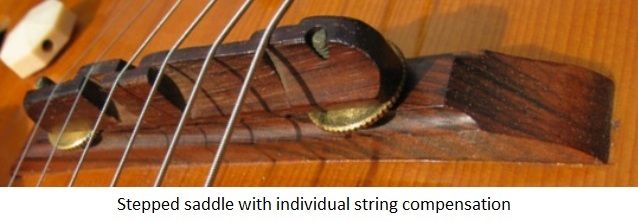Epiphone used almost exclusively rosewood for the adjustable bridges throughout the years of production. The bridge had a solid base with a separate saddle and a compensating angle for slightly longer bass and shorter treble string lengths. Vertical adjustment was by means of two threaded rods and thumb wheels, usually made of brass. Each bridge was hand-fitted to the contour of the top of the guitar for which it was made and many bridges even had the serial number of the guitar blind stamped on the underside of the bridge foot. (F & F, page 70)
For detailed information about Epiphpone bridges : Archtop bridge evolution 1931–1956
Some bridges from the late 1940s to early 1950s had the base made of a different, light colored wood, possibly pearwood or maple, sometimes stained to match the rosewood saddle, sometimes left natural on blond instruments.
Epiphone’s archtop bridges generally had an angled, straight-top saddle without individual string intonation compensation until c. 1950, when a stepped saddle for individual string compensation was introduced – first only on high end models, by 1953 also on lower models.


December 2016 Felix wrote us: “The price list of March 15, 1942 first introduced an “offset type bridge top” as an optional accessory. I am sure this is the stepped saddle part. It was not offered in the 1946-47 price lists, but again in the price lists of 1948 and later.”


Although bridges were hand-fitted to the contour of the top and many bridges even had the serial number blind stamped on the bridgefoot, one sometimes encounters bridges (or saddles) that do not originally belong to the guitar they are on. See for example Bridge De Luxe sn 12201 or the later stepped saddle on the older original bridgefoot of Blackstone sn 12345.


